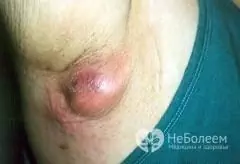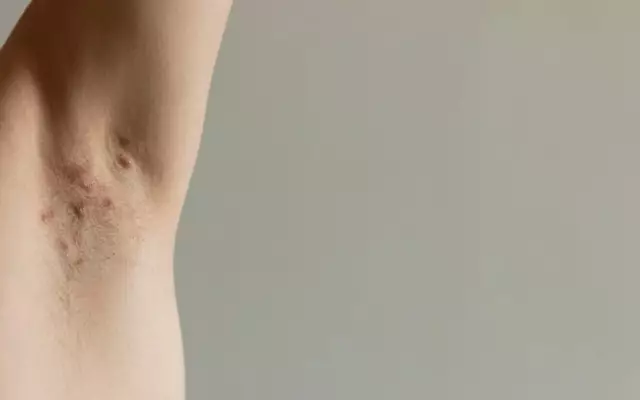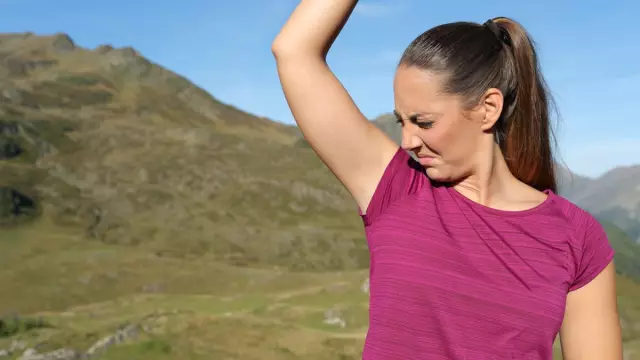- Author Rachel Wainwright [email protected].
- Public 2023-12-15 07:39.
- Last modified 2025-11-02 20:14.
Hydradenitis
Brief description of the disease
Hydradenitis is a disease associated with inflammation of the sweat glands. Since their greatest concentration is observed in the armpits, then hydradenitis most often occurs in the armpit area. The provoking factors are untidiness, poor body hygiene and excessive sweating. They lead to inflammation of the sebaceous gland, which rapidly increases in size and becomes similar to a cow's udder. Some other reasons can also cause hydradenitis, in particular, restructuring of the endocrine system or reduced immunity. If the patient is diagnosed with hydradenitis, the treatment includes a whole range of methods - from general strengthening procedures to surgery and the use of folk recipes.
Hydradenitis - symptoms of the disease

With inflammation of the sweat glands, a dense knot (sometimes several knots) appears in the armpit, which is first located under the skin, and then begins to protrude above its surface. The size of the formation ranges from 0.5 to 3 cm. Hydradenitis can be easily distinguished from boils and other purulent inflammations by its characteristic purple-cyanotic hue.
Note that the inflammatory process can move from one sweat gland to another, and also capture several excretory ducts at once. Hydradenitis is most common in the armpit, however, there are frequent cases of the appearance of formations in the pubic and peri-umbilical region or in the region of the scalp and on the neck.
Among the main symptoms that make it possible to diagnose the disease, it should be noted:
- the appearance of a dense knot that rises above the surface of the skin;
- constant itching in the area of inflammation, and sometimes sharp pain;
- increased body temperature;
- if untreated, scars, fistulous passages and comedones (blackheads) are formed.
Hydradenitis - treatment with standard drug methods
The inflamed area is treated with disinfectant solutions and antiseptic preparations. The most effective are shown by: bactericidal soap, 5% iodine tincture, 2% boric alcohol, neomycin (ointment) and lotions with 2% clindamycin solution. When diagnosed with hydradenitis, treatment should be accompanied by regular hygiene and body care. In the later stages, patients are recommended surgical treatment. It consists in opening and excising the affected tissue areas and removing the fistulous passages. Operative methods are used in cases where conservative treatment does not lead to the expected results.
Patients must be prescribed antimicrobial therapy: doxycycline (100 mg. 2 times a day), tetracycline (250 mg. 3-4 times a day), erythromycin (0.25 g. 3-4 times a day). The course of treatment lasts about 14 days.
If a person has recurrent hydradenitis, treatment involves specific immunotherapy, in which gamma globulin and staphylococcal vaccines are used.
In most cases, the prognosis of treatment is favorable, but it must be borne in mind that inflammations very rarely disappear on their own. Even if this happened, the disease will still manifest itself later, therefore, if there is a reasonable suspicion of hydradenitis, you need to urgently consult a doctor in order to avoid unpleasant consequences in the form of scars and fistulas.
Preventive measures include: hygiene, prevention of excess body weight, exclusion of cosmetics and perfumes that irritate the skin.
Hydradenitis - alternative treatment of the disease
When inflammation occurs, it is necessary to provide the patient with peace and change his standard diet to food rich in vitamins and microelements. From the time-tested folk remedies, we can single out the following recipes:
- aloe tree leaves are thoroughly washed with warm water, cut lengthwise and applied to the affected area. By themselves, aloe leaves are not able to cure the disease, but they have a bactericidal effect and are perfectly combined with other means;
- fresh plantain leaves are thoroughly kneaded in the hands until they begin to let the juice start. After that, they are applied to the hydradenitis under the arm for 15-20 minutes 3-4 times a day. Fresh plantain juice is also very effective;
- fresh celery leaves are washed in warm water, kneaded and applied to the affected area several times a day;
- when diagnosed with hydradenitis, folk remedies can be combined using a sea salt solution. It is prepared like this: 2 teaspoons of dry sea salt is dissolved in a glass of warm boiled water. The resulting mixture is filtered through several layers of gauze and is used to wash the inflamed area 4-5 times a day;
- one teaspoon of chamomile, sage, eucalyptus or calendula flowers is poured with a glass of boiling water. Then the solution is filtered and infused for a day. The inflamed area should be washed several times a day.
If a person is diagnosed with hidradenitis, alternative treatment can successfully replace surgical and other traditional methods, but before using decoctions and infusions, consult your doctor or consult an experienced homeopath.
YouTube video related to the article:
The information is generalized and provided for informational purposes only. At the first sign of illness, see your doctor. Self-medication is hazardous to health!






